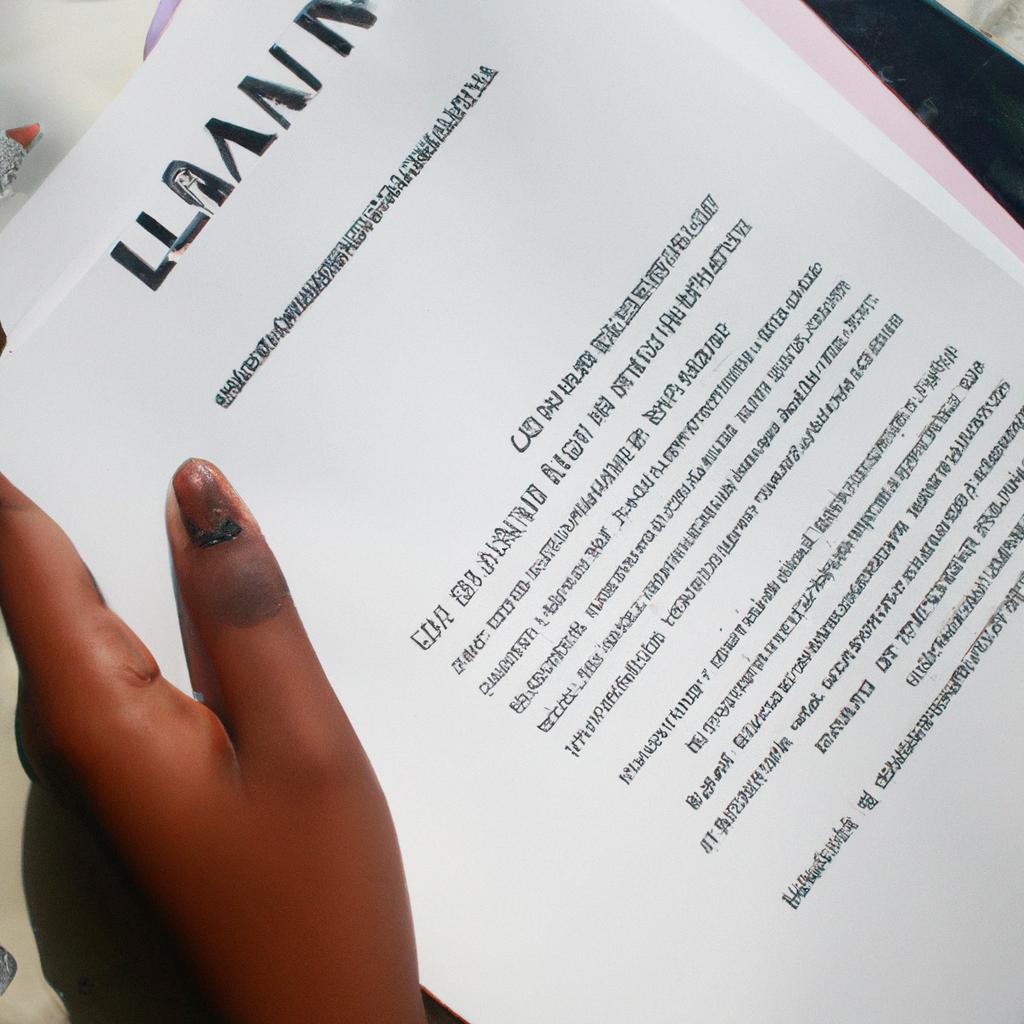Loan Term Options for Villas and Apartments: Residence Loans
In the realm of real estate financing, loan term options play a crucial role in determining the financial feasibility and viability of acquiring residential properties such as villas and apartments. The choice of loan terms directly affects the amount of monthly payments, interest rates, and overall cost over time. For instance, consider a hypothetical scenario where an individual is seeking to purchase a luxurious villa with breathtaking ocean views. In this case study, we will explore various residence loan term options available to potential buyers like our protagonist.
The decision on which loan term option to pursue depends on several factors including personal financial capabilities, long-term plans for the property, and risk tolerance. This article aims to provide an overview of common residence loan term options available in the market today for individuals interested in purchasing villas or apartments. By examining each option’s advantages and disadvantages, borrowers can make informed decisions that align with their specific needs and objectives. Furthermore, we will discuss key considerations when selecting between shorter or longer loan terms based on affordability, equity building potential, interest rates fluctuations, and exit strategies. Ultimately, understanding these aspects will empower prospective homeowners to navigate the complex landscape of residence loans effectively.
Understanding the Loan Term
When considering a loan for purchasing a villa or apartment, it is crucial to understand the various loan term options available. The loan term refers to the length of time within which you are expected to repay your mortgage in full. It plays a significant role in determining your monthly payments and overall cost of borrowing.
To illustrate this concept further, let’s consider an example: Mr. Smith wants to purchase a villa worth $500,000. He has two loan term options – 15 years and 30 years. With the 15-year term, he would have higher monthly payments but would be able to pay off his mortgage sooner. On the other hand, with the 30-year term, his monthly payments would be lower but he would take longer to fully repay the loan.
Considering these different scenarios, it becomes evident that selecting the right loan term requires careful consideration of one’s financial situation and long-term goals. To help you make an informed decision, here are some key points to keep in mind:
- Monthly Payments: Shorter loan terms generally result in higher monthly payments due to the shorter repayment period.
- Total Interest Paid: Longer loan terms may lead to paying more interest over time as compared to shorter terms.
- Equity Build-Up: Shorter loan terms allow homeowners to build equity faster and can provide greater financial security.
- Flexibility: Longer loan terms offer lower monthly payments, providing borrowers with increased flexibility in their budget.
| Loan Term | Monthly Payment ($) | Total Interest Paid ($) |
|---|---|---|
| 15 years | $3,400 | $218,000 |
| 30 years | $2,200 | $360,000 |
As seen from this table, opting for a 15-year term results in higher monthly payments but leads to significant savings on total interest paid throughout the life of the loan.
In considering the loan term options, it is essential to evaluate your financial capabilities and long-term goals. In the subsequent section, we will explore short-term loan options for those seeking greater repayment flexibility while maintaining financial stability.
Short-Term Loan Options
In order to make an informed decision when applying for a residence loan, it is crucial to have a clear understanding of the loan term options available. The loan term refers to the length of time over which you will be repaying the borrowed amount. This section will provide insight into different types of loan terms and their implications.
Let’s consider an example: Sarah is looking to purchase a villa in a picturesque location. She needs financing options that align with her financial goals and circumstances. Understanding the various loan term options can help her choose the most suitable option for her situation.
When considering residence loans, borrowers often encounter three main types of loan terms:
-
Short-term loans:
- Typically have a duration of 3-5 years.
- Generally come with higher monthly payments due to shorter repayment periods.
- Can be advantageous for those seeking quick ownership or planning on selling the property within a short timeframe.
- Example bullet point:
- Promptly become debt-free
- Enjoy lower interest rates
- Build equity faster
- Potential for quicker resale opportunities
-
Medium-term loans:
- Usually range from 10-15 years in duration.
- Offer a balance between shorter and longer-term options.
- Monthly payments are more affordable compared to short-term loans but may still require careful budgeting.
- Allow borrowers enough time to build equity while making steady progress towards full ownership.
-
Long-term loans:
- Have durations typically exceeding 20 years or even up to 30 years.
- Commonly associated with smaller monthly payments due to extended payment schedules.
- Provide flexibility by spreading out repayments over a longer period, potentially reducing financial strain.
To further illustrate these differences, let’s take a look at this table comparing short-term, medium-term, and long-term loan options:
| Short-Term Loans | Medium-Term Loans | Long-Term Loans | |
|---|---|---|---|
| Duration | 3-5 years | 10-15 years | 20+ years |
| Monthly Payments | Higher | Affordable | Smaller |
| Benefits | Prompt debt-free, lower interest rates, faster equity building, potential for quicker resale opportunities. |
In conclusion, understanding the loan term options available when applying for a residence loan is essential in making an informed decision that aligns with your financial goals and circumstances. Short-term loans offer quick ownership and potential cost savings, medium-term loans strike a balance between affordability and progress towards full ownership, while long-term loans provide flexibility through smaller monthly payments over extended periods of time. Now let’s explore the next section on “Long-Term Loan Options” to further expand our knowledge in this area.
Long-Term Loan Options
Loan Term Options for Villas and Apartments: Residence Loans
In the previous section, we discussed short-term loan options for individuals looking to finance their villas or apartments. Now, let’s explore long-term loan options that provide borrowers with more extended repayment periods.
When considering long-term loans for residential properties, it is essential to understand the benefits and drawbacks associated with these financing options. Let’s consider an example of a hypothetical borrower named Jane, who recently purchased a villa and needs a loan to cover its cost. By examining different loan term options available to her, we can gain insights into making informed decisions.
Here are some key considerations when evaluating long-term loan options:
- Loan Duration: Long-term loans typically offer longer repayment periods compared to short-term loans. This means that borrowers like Jane can spread out their payments over several years, resulting in lower monthly installments.
- Interest Rates: Since long-term loans involve higher principal amounts and extend over lengthy durations, they often come with slightly higher interest rates than short-term loans. Borrowers should carefully analyze how this affects their overall financial situation before committing to such loans.
- Flexibility: Long-term loans allow borrowers greater flexibility in managing their finances as smaller monthly payments can be easier on cash flow. However, it is crucial to balance this advantage against potential disadvantages such as increased total interest paid over the life of the loan.
- Future Plans: Consider your future plans regarding the property you intend to purchase. If you plan to sell or refinance within a few years, opting for a shorter loan term might be more suitable.
To further illustrate the comparison between short- and long-term residence loans, refer to the following table:
| Loan Option | Short-Term Loan | Long-Term Loan |
|---|---|---|
| Repayment Period | 5 years | 25 years |
| Monthly Payment | Higher | Lower |
| Total Interest | Less | More |
| Flexibility | Limited | Greater |
As we can see, long-term loans offer advantages in terms of lower monthly payments and increased flexibility. However, borrowers must carefully evaluate their financial goals and the impact of interest rates over an extended period.
Variable Rate Loans. By understanding these options, borrowers like Jane can make more informed decisions about which type of loan best suits their needs and preferences.
Fixed Rate vs. Variable Rate Loans
In the previous section, we explored long-term loan options available to individuals seeking residence loans. Now, let us delve into an important consideration when choosing a loan term – fixed rate vs. variable rate loans. To better understand this choice, let’s consider the case of Mr. Johnson, who is contemplating purchasing his dream villa.
Mr. Johnson has been saving diligently for years and has finally found the perfect villa that meets all his requirements. He approaches a financial institution to secure a residence loan for his purchase. As he explores different loan term options, he comes across two main types – fixed rate loans and variable rate loans.
Fixed Rate vs Variable Rate Loans
To aid in Mr. Johnson’s decision-making process, below are some key differences between fixed rate and variable rate loans:
- Interest Rates: Fixed-rate loans offer stability as they maintain the same interest rate throughout the loan term, ensuring consistent monthly payments. On the other hand, variable-rate loans have interest rates that fluctuate based on market conditions.
- Payment Predictability: With a fixed-rate loan, borrowers can accurately predict their monthly payments over the entire duration of the loan term. In contrast, variable-rate loans introduce uncertainty due to potential fluctuations in interest rates.
- Flexibility: While fixed-rate loans provide peace of mind by locking in an interest rate, they typically offer less flexibility compared to variable-rate loans. Variable-rate loans may come with features such as introductory low rates or periodic adjustments that allow borrowers to take advantage of favorable market conditions.
- Risk Tolerance: Choosing between fixed and variable rates often depends on one’s risk tolerance level. If Mr. Johnson prefers stable payments without worrying about potential interest rate increases in the future, a fixed-rate loan might be more suitable for him. However, if he believes that interest rates will decrease or wants to benefit from potential savings during a low-rate period, he may opt for a variable-rate loan.
Now that we have explored the differences between fixed rate and variable rate loans, let us move on to the next section where we will discuss factors to consider when choosing loan terms. It is essential to carefully evaluate these factors before making a decision to ensure the most suitable loan option for Mr. Johnson’s villa purchase.
Factors to Consider when Choosing Loan Terms
Loan Term Options for Villas and Apartments: Residence Loans
In the previous section, we discussed the differences between fixed rate and variable rate loans. Now, let’s delve into the various factors you should consider when choosing loan terms for your villa or apartment.
To illustrate these considerations, let’s take the example of Mr. Smith who is planning to purchase a luxurious villa in an upscale neighborhood. Mr. Smith wants to compare different loan term options before making his final decision. By analyzing this case study, we can gain insights into the importance of selecting appropriate loan terms.
When contemplating loan term options for residence loans, there are several key factors that demand careful consideration:
- Financial Stability: Assessing your current financial stability is crucial as it determines how much risk you can afford to bear over time.
- Future Plans: Consider your long-term plans regarding the property – whether you plan to live in it indefinitely or sell it after a few years.
- Interest Rates Outlook: Stay informed about prevailing interest rates and their projected future trends to make an informed decision on fixed or variable rate loans.
- Repayment Capacity: Evaluate your ability to meet monthly repayments comfortably while still managing other essential expenses.
To better understand these factors, here is a table summarizing their impact on loan term selection:
| Factors | Impact |
|---|---|
| Financial | Determine affordability |
| Stability | |
| —————— | ————————– |
| Future Plans | Affects length of term |
| chosen | |
| —————— | ————————– |
| Interest Rates | Dictate cost of borrowing |
| Outlook | |
| —————— | ————————– |
| Repayment | Influences flexibility |
| Capacity |
Considering these factors will help you navigate through available loan term options more effectively and choose one that aligns with your specific needs and circumstances.
Moving forward, let’s explore some useful tips for negotiating loan terms that can further assist you in making informed decisions about your villa or apartment purchase without compromising financial stability and long-term goals.
Tips for Negotiating Loan Terms
When deciding on loan terms for villas and apartments, there are several important factors that should be taken into consideration. These factors can greatly impact the overall financial burden and feasibility of repaying the loan. One example is a hypothetical scenario involving two potential borrowers, John and Sarah, who are both looking to purchase properties in the same area.
-
Interest Rate: The interest rate plays a crucial role in determining the affordability of a loan. A lower interest rate will result in lower monthly payments and potentially save thousands of dollars over the life of the loan. In our case study, John managed to secure a loan with an interest rate of 3%, while Sarah settled for a higher rate at 4%. This small difference may not seem significant initially but can lead to substantial savings for John over time.
-
Loan Duration: The term length of the loan also impacts its affordability. Shorter terms generally mean higher monthly payments but less total interest paid over time. On the other hand, longer terms provide more manageable monthly payments but could result in paying significantly more interest throughout the duration of the loan. In our example, John opted for a 15-year term while Sarah chose a 30-year term.
-
Down Payment: The amount paid upfront as a down payment affects both eligibility for loans and their subsequent repayment costs. A larger down payment reduces the principal amount borrowed, resulting in smaller monthly installments or shorter repayment periods. Conversely, a smaller down payment requires borrowing more money, leading to increased monthly payments or extended loan durations.
-
Flexibility: Some lenders offer flexible loan terms that allow borrowers to adjust their repayment plans based on changes in income or financial circumstances. Such flexibility can be beneficial if unexpected events occur during the course of homeownership that affect one’s ability to make regular mortgage payments.
- Financial stability
- Peace of mind knowing you can comfortably afford the loan
- Potential savings on interest payments
- Ability to adjust repayment plans in case of unforeseen circumstances
Now, let’s include a table with three columns and four rows to provide additional information:
| Factors | John | Sarah |
|---|---|---|
| Interest Rate | 3% | 4% |
| Loan Duration | 15 years | 30 years |
| Down Payment | $100,000 | $50,000 |
| Flexibility | Yes | No |
In this example, John made a larger down payment, secured a lower interest rate, and opted for a shorter loan duration. As a result, he not only has smaller monthly payments but also saves significantly on total interest paid over time compared to Sarah.
By carefully considering these factors when choosing loan terms for villas and apartments, potential borrowers can make informed decisions that align with their financial goals and circumstances. It is essential to evaluate different options thoroughly before committing to any particular loan term arrangement.
 Villas In Florence
Villas In Florence



